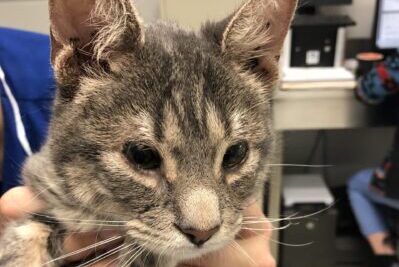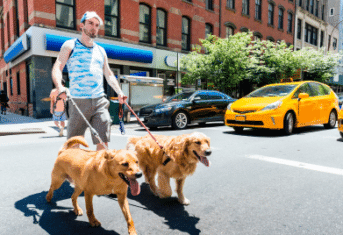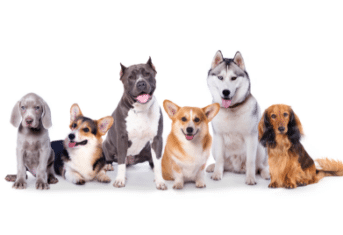Does Your Pet Have an Innie or an Outie?

Does Your Pet Have an Innie or an Outie?
This is Joey, who you have met before my blog titled “The War Horse Kitten.” Not only did she have a serious esophageal problem which was corrected at The Animal Medical Center, but she also had an “outie” belly button seen at the tip of the arrow.
What is a belly button?
The navel, or scientifically speaking, an umbilicus, is where the blood vessels from the placenta attach to a baby before it is born. The blood vessels are an in utero life support system providing nutrition, oxygen and waste product removal. Once a baby is born, it no longer needs the blood vessel, which then dries up and falls off. The photo of the one-day-old puppy at right shows just a scab where the blood vessel had been the day before. In an adult dog or cat, the belly button is very different than that of a human. Belly buttons are typically flat, without hair and often white like a scar. Even though pets are covered with hair, the bellybutton is easy to find since they occur at a cowlick of hair on the abdomen.
What determines an innie or an outie?
Outies are not very common in humans and some estimates suggest only 10% of the population has an outie. Since most births of puppies and kittens are not attended by a veterinarian, I wasn’t sure what the determining factors for the type of belly button were. I contacted a friend who is an obstetrician at Bellevue Hospital in New York City. She has delivered a lot of human babies and I thought she could shed some light on my question. My obstetrician friend says, “When a human baby is born, two clamps are put on the umbilical vessels by the obstetrician. The placenta is separated from the baby by cutting between the two clamps. When the baby is discharged from the hospital nursery, the clamp is left on the umbilical vessel, which falls off a few days later.” The clamp nearest the baby is nowhere near the belly button location and in my friend’s expert opinion, a belly button happens on its own; she has no control over whether it’s an innie or an outie.
Why did Joey have an outie?
In some cats, dogs and people, the muscles of the abdominal wall do not close completely around the umbilical cord during development. The defect in the body wall is called a hernia and in severe cases, abdominal organs can protrude through the hole. Joey had an umbilical hernia which did not cause any medical problems but was successfully repaired at the time of her spay surgery since the umbilicus is near where the spay incision is routinely placed.
Interesting research is being conducted into human belly buttons by the Belly Button Biodiversity Project.
________________________________________________________
This may also be found in the “Tales from the Pet Clinic” blog on WebMD.com.
For over a century, The Animal Medical Center has been a national leader in animal health care, known for its expertise, innovation and success in providing routine, specialty and emergency medical care for companion animals. Thanks in part to the enduring generosity of donors, The AMC is also known for its outstanding teaching, research and compassionate community funds. Please help us to continue these efforts. Send your contribution to: The Animal Medical Center, 510 East 62nd Street, New York, NY 10065. For more information, visit www.amcny.org. To make an appointment, please call 212.838.7053.


































